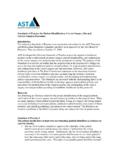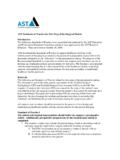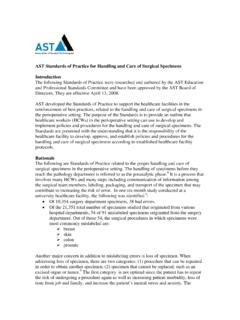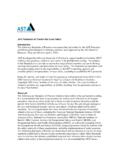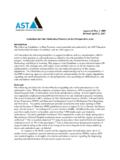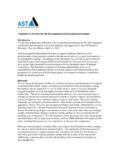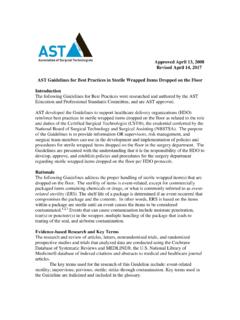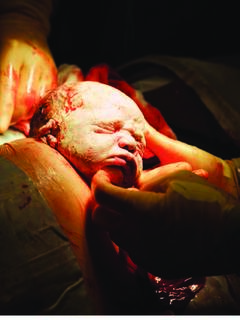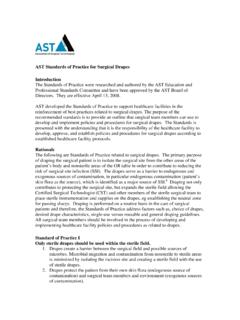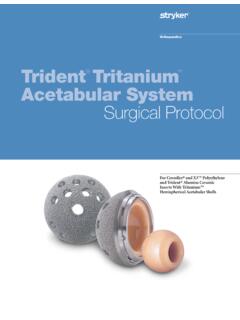Transcription of Standard Patient Transportation
1 Recommended Standards of Practice for Patient Transportation Introduction The following Standards of Practice were researched and written by the AST Education and Professional Standards Committee and have been approved by the AST Board of Directors. They are effective October 27, 2006. AST developed the following Standards of Practice to provide support to healthcare facilities in the reinforcement of safe transfer and Transportation of the Patient in the perioperative setting. The purpose of the Standards is to provide an outline that healthcare workers (HCWs) in the perioperative setting can use to develop and implement policies and procedures for safe transfer and Transportation of the Patient .
2 The recommended Standards is presented with the understanding that it is the responsibility of the healthcare facility to develop, approve and establish policies and procedures for the safe transfer and Transportation of the Patient according to established healthcare facility protocols. Rationale The following are recommended practices related to the safe care of transporting patients to the operating room and recognizing the possible hazards, in order to prevent injuries to the Patient and surgery department personnel.
3 The recommended practices aid in ensuring the transfer and Transportation of the Patient without tissue injury; avoiding undue physical or emotional discomfort; and avoiding severe alterations in body temperature, respirations, and cardiovascular reactions, including hypotension and tissue Standard of Practice I. It is the responsibility of the HCWs to ensure the safe Patient transfer of a Patient from a bed to a Transportation device. 1. The specific needs of the Patient should be considered when selecting the method of transport.
4 This includes: A. Need for IV pole(s). B. Need to transport oxygen tank C. Mobility of the Patient D. Conscious, semi-conscious or unconscious Patient E. Size of Patient F. Age of Patient G. Determining the physical abilities and state of health of the Patient . Knowing the Patient 's state of health and abilities will help in the choice of mode of Transportation , decrease the possibility of accidents to the Patient and hospital personnel, and aid in determining the number of hospital personnel needed to help move the Patient .
5 2. The following parameters should be considered when identifying the mode of Transportation to be utilized to promote the safety of the Patient and hospital personnel: A. Wheels can be locked B. Safety straps available C. Side rails are high enough D. Rails on crib are high enough to prevent pediatric Patient from falling out E. IV poles can be easily transferred with the chosen method of transport F. Shelf or rack is available in order to transport oxygen tank and/or monitoring devices G. Method of transport is large enough to accommodate size of Patient H.
6 Ability to accommodate positioning needs of the Patient I. Mattress on gurney is held in place J. Ability to use Patient transfer devices K. Maneuverability of Transportation device L. The Transportation device has undergone scheduled inspections, maintenance and repair to ensure proper functioning 3. To ensure the safety of the Patient and HCWs, the following safety measures should be implemented during the transfer of the Patient : A. Adequate number of HCWs is available to transfer the Patient . The assessment of the Patient will aid in determining the number of personnel that will be needed.
7 For the conscious, mobile Patient , a minimum of two personnel is required. For the semi-conscious or unconscious, nonmobile Patient , a minimum of four personnel is B. To promote the safety of the nonmobile Patient and staff members, Patient transfer devices are recommended for use. These devices include rollers and hoists. C. Adjust the furniture and equipment in the room to ensure adequate space for the safe transfer of the Patient . D. Position the gurney as close against the Patient 's bed as possible. E. Use locking devices on wheels of Transportation method to prevent the Patient from falling.
8 F. Ensure wheels on Patient bed are locked if wheels are present. G. Secure the accessory items, such as IV lines and drainage devices before transferring the Patient ; ensure the lines remain patent and functioning 4. The following Patient care concepts should be implemented during the transfer of the Patient : A. Individual who is transporting the Patient should introduce and identify herself/himself to lessen Patient anxiety. B. Correctly identify the Patient to prevent wrong- Patient surgery. C. If the Patient is conscious, explain the transfer procedure prior to implementation to reduce the anxiety of the Patient and promote safety.
9 Verbally communicate to the Patient which staff member will indicate that they are ready for the Patient to move over to the Transportation device. Instruct the Patient to move slowly to avoid severe physiological alterations; assist the Patient with D. Maintain the Patient 's dignity during the transfer by keeping him/her covered. This will aid in decreasing the Patient 's anxiety and ensure his/her personal and moral rights. Standard of Practice II. It is the responsibility of the HCWs to safely transport a Patient to the preoperative holding area or operating room.
10 1. To ensure the safety of the Patient and HCWs, the following safety measures should be implemented during the transport of the Patient : A. Elevate the side rails. B. Apply safety strap. C. Confirm IV lines, indwelling catheters, monitoring system lines and drains, and any other lines are secure and patent, and IV bag and collection containers are hanging away from the Patient 's head. D. Ensure head, arms and legs are protected, adequately padded, and Patient is comfortable as possible. E. The Patient should be transported feet first; rapid movements, particularly when going around a corner should be avoided.
